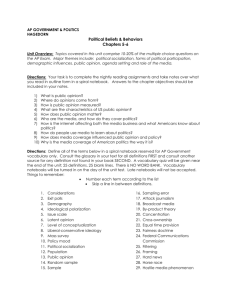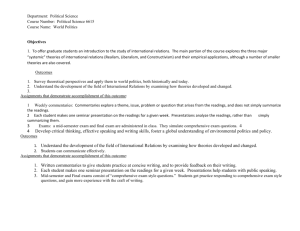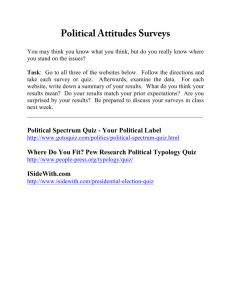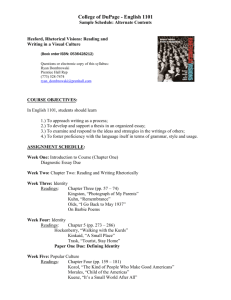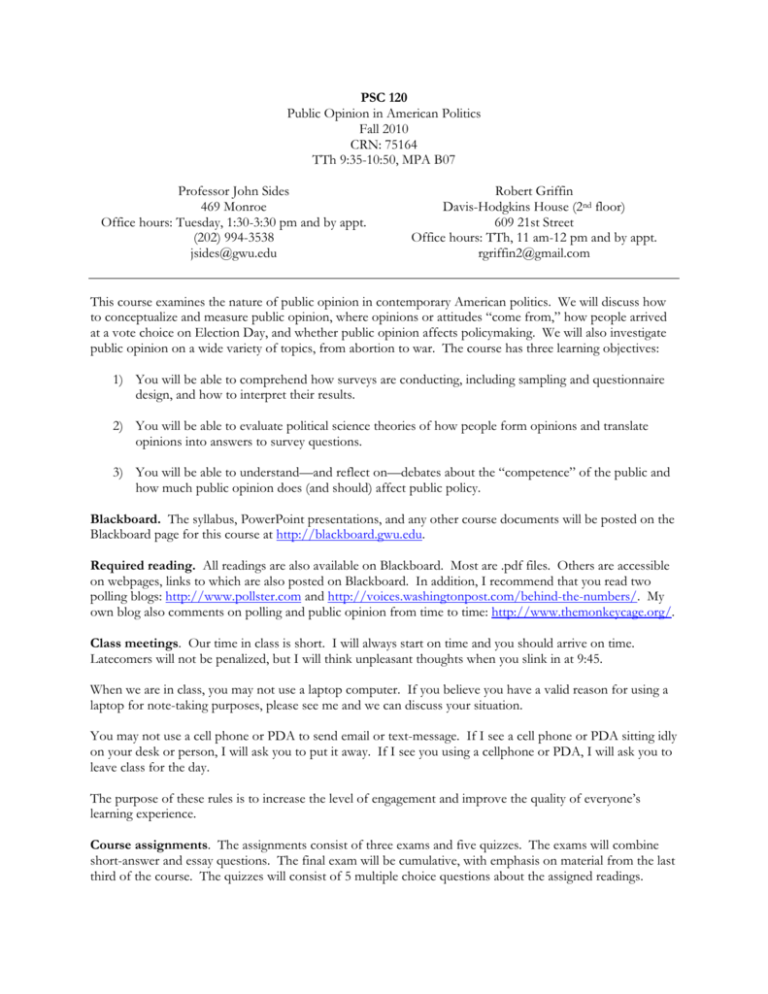
PSC 120
Public Opinion in American Politics
Fall 2010
CRN: 75164
TTh 9:35-10:50, MPA B07
Professor John Sides
469 Monroe
Office hours: Tuesday, 1:30-3:30 pm and by appt.
(202) 994-3538
jsides@gwu.edu
Robert Griffin
Davis-Hodgkins House (2nd floor)
609 21st Street
Office hours: TTh, 11 am-12 pm and by appt.
rgriffin2@gmail.com
This course examines the nature of public opinion in contemporary American politics. We will discuss how
to conceptualize and measure public opinion, where opinions or attitudes “come from,” how people arrived
at a vote choice on Election Day, and whether public opinion affects policymaking. We will also investigate
public opinion on a wide variety of topics, from abortion to war. The course has three learning objectives:
1) You will be able to comprehend how surveys are conducting, including sampling and questionnaire
design, and how to interpret their results.
2) You will be able to evaluate political science theories of how people form opinions and translate
opinions into answers to survey questions.
3) You will be able to understand—and reflect on—debates about the “competence” of the public and
how much public opinion does (and should) affect public policy.
Blackboard. The syllabus, PowerPoint presentations, and any other course documents will be posted on the
Blackboard page for this course at http://blackboard.gwu.edu.
Required reading. All readings are also available on Blackboard. Most are .pdf files. Others are accessible
on webpages, links to which are also posted on Blackboard. In addition, I recommend that you read two
polling blogs: http://www.pollster.com and http://voices.washingtonpost.com/behind-the-numbers/. My
own blog also comments on polling and public opinion from time to time: http://www.themonkeycage.org/.
Class meetings. Our time in class is short. I will always start on time and you should arrive on time.
Latecomers will not be penalized, but I will think unpleasant thoughts when you slink in at 9:45.
When we are in class, you may not use a laptop computer. If you believe you have a valid reason for using a
laptop for note-taking purposes, please see me and we can discuss your situation.
You may not use a cell phone or PDA to send email or text-message. If I see a cell phone or PDA sitting idly
on your desk or person, I will ask you to put it away. If I see you using a cellphone or PDA, I will ask you to
leave class for the day.
The purpose of these rules is to increase the level of engagement and improve the quality of everyone’s
learning experience.
Course assignments. The assignments consist of three exams and five quizzes. The exams will combine
short-answer and essay questions. The final exam will be cumulative, with emphasis on material from the last
third of the course. The quizzes will consist of 5 multiple choice questions about the assigned readings.
2
Simply showing up for the quiz earns you a 50; each correct answer is worth 10 additional points. The
quizzes will give you some added incentive to do the reading and help you prepare for the exams.
Some key dates:
Sept. 14
Sept. 30
Oct. 7
Oct. 26
Nov. 4
Nov. 18
Dec. 2
TBD
first quiz
second quiz
first exam
third quiz
second exam
fourth quiz
fifth quiz
final exam
The date of the final exam will be set by the Registrar’s Office. I do not have any control over it. You must
take the final exam at this date and time. There are no exceptions to this rule.
Course grades. Your grade in the course will be a weighted average of the assignments:
15%
25%
25%
35%
quizzes (3% each)
first exam
second exam
final exam
I will grade on the following scale: A (93-100), A- (90-92), B+ (87-89), B (83-86), B- (80-82), C+ (77-79), C
(73-76), C- (70-72), D (60-69), and F (0-59). Note that there are no +/- grades in the D or F range.
Here are several important details of my policy on course grades:
• If you have questions about the grade you received on an assignment, both Rob and I are happy to answer
those questions and to suggest ways that you can do better.
• If you do not think that the grade you received reflects the quality of your work, you may ask for the
assignment to be graded again. To do so, submit a formal appeal in writing, explaining why you think the
grade you received is not a fair reflection of the quality of your work. The new grade, whether higher or
lower, will then become your final grade on this assignment.
• If you do not complete an assignment, you will receive you a 0 for the assignment.
• I do not tolerate late assignments. I will lower your grade one-half of a letter grade for each day it is late.
That is, if the assignment is due on Tuesday and you complete it on Wednesday, the highest grade you can
make is a B+. If you complete it on Thursday, the highest grade you can make is a B-. And so forth.
• The only acceptable excuses for not completing an assignment on time are illness or family emergency. If
either circumstance arises, I will give you extra time, but only if you (1) communicate with me before the
assignment is due, and (2) provide documentation of the circumstance. You must do both of these things
in order to avoid penalties for a late assignment. Judging from my own experiences and those of my
colleagues, having a grandchild at GW is incredibly hazardous to your health. Thus, I must verify even
deaths in the family. Better yet, you may communicate directly with the Dean of Students and that office
can notify faculty of your absence.
• There are no opportunities to re-do assignments or to do extra-credit work in this course.
• I do not “curve” grades. At the end of the semester, I will calculate your grade as described above and
then round to the nearest whole number (e.g., an 86.5 becomes an 87). That grade becomes your final
3
grade. I will not increase any person’s grade solely to change their letter grade. So if you make an 89.4,
you will make a B+, not an A-. No amount of pleading will change this outcome. Particularly common
and ineffective are pleas claiming that your grade in this class will cause you to lose a scholarship, prevent
you from attending the graduate or professional school of your choice, or lead to some other unfortunate,
but unlikely, consequence. Even more ineffective are pleas that contain false statements such as “This is
the only B that I received this semester” that I can easily debunk with a glance at your transcript.
Academic dishonesty. In the Code of Academic Integrity, the University defines academic dishonesty as
“cheating of any kind, including misrepresenting one’s own work, taking credit for the work of others without
crediting them and without appropriate authorization, and the fabrication of information.” Scholastic
dishonesty also includes, but is not limited to, providing false or misleading information to receive a
postponement or extension on a test, quiz, or assignment, and submission of essentially the same written
assignment for two different courses without the prior permission of faculty members. By accepting this
syllabus and participating in the course, you have agreed to abide by this Code. Students who violate the
Code are subject to disciplinary penalties, including failure on the assignment in question, failure in the course,
and other penalties imposed by the University. See: http://www.gwu.edu/~ntegrity/index.html
Medical needs, illnesses, and other emergencies. As noted above, if a medical need will result in your
missing or completing assignments, please communicate with me. I am willing to be accommodating but
communication and documentation is necessary.
Special needs. George Washington University provides appropriate academic accommodations for qualified
students with disabilities. To determine if you qualify, contact the Disability Support Services at (202) 9948250 (V/TDD). If they certify your needs, I will work with you to make arrangements.
Religious holy day observance. If an assignment or exam is due on a day when you are observing a
religious holy day, I will work with you to find an acceptable alternative time to complete the assignment.
Course Plan
Aug. 31, Sept. 2
Introduction
Here is a list of five important things in this week’s readings. In the Key reading, pay attention to these topics:
(1) different views about the role of public opinion in a democratic political system (e.g., that of the
Progressives, Lippman, the “New Machiavellians”); (2) different conceptions of public opinion; (3)
characteristics of public opinion; and (4) his definition of public opinion (p. 14). Gallup (the name should
ring a bell!) discusses how surveys contribute to democracy. The Zaller reading provides a fundamental
theory about opinion formation and change. Make sure and understand: (4) the definition of “information,”
“predispositions,” and “political awareness”; and (5) the “question-answering” model of survey response.
•
V.O. Key. 1961. Public Opinion and American Democracy. New York: Knopf. pp. 3-18.
•
Gallup, George. 1948. A Guide to Public Opinion Polls. Princeton: Princeton University Press. pp. 313.
•
Zaller, John. 1992. The Nature and Origins of Mass Opinion. pp. 6-39.
4
September 7, 9
Measuring Public Opinion with Surveys
These readings concern various aspects of the survey process. First major topic is sampling, or drawing a
“sample” of “respondents” from a “population” (learn those words). See Gallup pp. 14-20 and pp.73-75.
(Gallup refers to the Literary Digest poll of 1936 on pp.73-75. If you need more information about that poll,
see http://en.wikipedia.org/wiki/Literary_Digest.) The readings about response rates (Langer, Keeter et al.)
and cell phones involve the quality of the sample as well. The third topic—pre-election polls—engages a
variety of issues, including cell phones, the “Bradley effect,” choosing likely voters, etc. The fourth topic is
question wording and ordering (Asher, ch. 3). The last topic is analyzing and interpreting polls (Asher, ch. 8).
•
Gallup, George. 1948. A Guide to Public Opinion Polls. Princeton: Princeton University Press. pp. 1420, 73-75.
•
On response rates:
- Langer, Gary. 2003. “About Response Rates.” Public Perspective (May/June): 16-18.
http://www.aapor.org/Content/NavigationMenu/PollampSurveyFAQs/DoResponseRatesMatteR/
Response_Rates_-_Langer.pdf
- Keeter, Scott et al. 2006. “Gauging the Impact of Growing Nonresponse on Estimates from a
National RDD Telephone Survey.” Public Opinion Quarterly 70(5): 759-779.
•
On the consequences of cell phones for phone polling:
http://pewresearch.org/assets/pdf/1601-cell-phone.pdf
•
On the challenges of pre-election polling:
- Zukin, Cliff. “Sources of Variation in Public Election Polling: A Primer.”
http://www.aapor.org/uploads/zukin_election_primer.pdf
- Keeter Scott, et al. 2009. “Perils of Polling in the 2008 Election.”
http://pewresearch.org/assets/pdf/1266.pdf
•
On question wording and the interpretation of polls:
Asher, Herbert. 2001. Polling and the Public: What Every Citizen Should Know. Washington DC:
Congressional Quarterly Press. Chapters 3 and 8.
September 14, 16
Developing a Political Self
How do we come to be a “political” person? And how are political attitudes shaped throughout adolescence
and adulthood? Carter and Teten reassess the political views of children, while Jennings et al. consider the
influence of the family. In both readings, pay attention to how different contextual influences—political eras,
parents—may influence children. Wilcox and Carr introduce an important way of thinking about attitude
change: “period effects,” “generational effects,” and “life-cycle effects.” Putnam presents a generational
explanation for the apparent decline in civic engagement and social trust.
•
September 14: QUIZ on readings from Aug. 31-Sept. 9
• Carter, Amy, and Ryan L. Teten. 2006. “Assessing Changing Views of the President: Revisiting
Greenstein’s Children and Politics.” Presidential Studies Quarterly 32(3): 453-462.
• Jennings, M. Kent, Laura Stoker, and Jake Bowers. 2009. “Politics Across Generations: Family
Transmission Reexamined.” Journal of Politics 71(3): 782-799.
•
Wilcox, Clyde, and Patrick Carr. 2009. “The Puzzling Case of the Abortion Attitudes of the
Millenial Generation.” In Barbara Norrander and Clyde Wilcox (eds.), Understanding Public Opinion
(3rd ed.). Washington DC: Congressional Quarterly Press.
•
Putnam, Robert D. 2000. Bowling Alone: The Collapse and Revival of American Community. New
York: Simon & Schuster. Chapter 14.
5
September 21, 23
Economics or Emotions? The Impact of Self-Interest and Symbols
Do people base their political attitudes on their self-interest? Both Citrin and Green and Bartels say,
essentially, “not often.” What is their evidence? How does the Green and Gerken piece on smoking and
cigarettes fit with their account? Sears presents an alternative theory of opinion formation and change. Be
able to outline his theory and the notion of “symbolic predispositions.”
•
Citrin, Jack, and Donald Green. 1990. “The Self-Interest Motive in American Public Opinion.”
Research in Micropolitics 3: 1-28.
•
Bartels, Larry. 2004. “Unenlightened Self-Interest: The Strange Appeal of the Estate Tax Repeal.”
The American Prospect 15 (6): A17-A19.
•
Green, Donald, and Ann Elizabeth Gerken. 1989. “Self-Interest and Public Opinion toward
Smoking Restrictions and Cigarette Taxes.” Public Opinion Quarterly 53(1): 1-16.
•
Sears, David O. 1993. “Symbolic Politics: A Socio-Psychological Theory.” In Shanto Iyengar and
William J. McGuire (eds.), Explorations in Political Psychology. Durham, NC: Duke University Press.
Sept. 28, 30, Oct. 5
Group Identities and the “Circle of We”
Numerous violent conflicts—e.g., in Bosnia, Rwanda, and Iraq—illustrate how group identities influence
politics. We will examine cases that are, at least as of today, less dramatic: ethnic identities in the United
States. We consider two questions. First, do different ethnic group have different opinions? Kinder and
Winters focus on white and black Americans. Citrin examines Asians and Latinos in addition to whites and
blacks. In these readings, note how (and why) ethnic groups are different or similar. The reading by Brader
et al. considers how someone else’s ethnicity may affect our opinions. In their experiments, they manipulate
the ethnic identity of an immigrant depicted in a news story. What effects does this manipulation have?
•
Sept. 30: QUIZ on readings from Sept. 14-23
•
Kinder, Donald R., and Nicholas Winter. 2001. “Exploring the Racial Divide: Blacks, Whites, and
Opinion on National Policy.” American Journal of Political Science 45(2): 439-56.
•
Citrin, Jack. 2001. “The End of American Identity?” In Stanley A. Renshon (ed.), One America?
Political Leadership, National Identity, and the Dilemmas of Diversity. Washington DC: Georgetown
University Press.
•
Brader, Ted, Nicholas A. Valentino, and Elizabeth Suhay. 2008. “What Triggers Public Opposition
to Immigration? Anxiety, Group Cues, and Immigration Threat.” American Journal of Political Science
52(4): 959-978.
October 7
FIRST EXAM (covers material from Aug. 31-Oct. 5)
October 12, 14
Are We Prisoners of the Media?
We consume enormous amounts of information from the print, broadcast, and web-based media. But how
much do these media affect our political attitudes? In these readings, focus first on the different kinds of
effects the media can have—e.g., Zaller’s account of opinion change and Bosso’s account of agenda-setting.
Second, identify the factors that determine when media messages will affect us. Sears and Kosternan, as well
as Zaller, discuss this issue.
6
•
Sears, David O., and Richard Kosterman. 1994. “Political Persuasion.” In Sharon Shavitt &
Timothy C. Brock (eds.), Persuasion: Psychological Insights and Perspectives. Boston: Allyn & Bacon. pp.
251-278.
•
Zaller, John. 1992. The Nature and Origins of Mass Opinion. Chapters 3 and 6.
•
Bosso, Christopher. 1989. “Setting the Agenda: Mass Media and the Discovery of Famine in
Ethiopia.” In Michael Margolis and Gary A. Mauser (eds.), Manipulating Public Opinion: Essays on Public
Opinion as a Dependent Variable. Pacific Grove, CA: Brooks/Cole Publishing.
October 19
Casualties or Cues? Public Opinion about War
How does the public decide whether to support a war? How sensitive to casualties is the public? Hallin
examines media coverage of the Vietnam War, and critiques the idea that the media undermined the war
effort with a relentless focus on casualties. What is more important than casualties in determining the tone of
coverage? Berinsky compares the effects of “events” versus “elites.” Which matters more? How does his
story compare with Hallin’s?
•
Hallin, Daniel C. 1984. “The Media, the War in Vietnam, and Political Support: A Critique of the
Thesis of an Oppositional Media.” Journal of Politics 46(1): 2-24.
•
Berinsky, Adam J. 2007. “Assuming the Costs of War: Events, Elites, and American Public Support
for Military Conflict.” Journal of Politics 69(4): 975-997. http://web.mit.edu/berinsky/www/acw.pdf.
October 21
Red & Blue America—Are We Really Divided?
The David Brooks article introduced the idea of red and blue America—an idea that has metastasized
throughout political discourse. But is it accurate? Issenberg critiques Brooks’ reporting. Fiorina and Abrams
critique the broader idea. Is their contrarian perspective persuasive? What does the Jacobson reading suggest
about how, and on which issues, the American public is polarized.
•
Brooks, David. 2001. “One Nation, Slightly Divisible.” Atlantic Monthly (December).
•
Issenberg, Sasha. 2004. “Boo-Boos in Paradise.” Philadelphia Magazine (April).
http://www.phillymag.com/articles/booboos_in_paradise/.
•
Fiorina, Morris P., and Samuel J. Abrams. 2008. “Political Polarization in the American Public.”
Annual Review of Political Science 11: 563-88.
•
Jacobson, Gary. 2006. A United, Not a Divider: George W. Bush and the American People. New York:
Pearson Longman. Chapter 1 and pp. 119-151.
October 26, 28
A “Dunce Cap Nation”?
How much do Americans know about politics? Do Americans even have real beliefs about political issues?
The readings this week suggest that the answers to these questions are “not much” and “not really.” Is there
cause for concern? Is the public capable of fulfilling the requirements of democratic citizenry?
•
Oct. 26: QUIZ on readings from Oct. 12-21
•
Read this discussion of a Newsweek survey about political knowledge. Be sure and click through to
the Newsweek story and the results of the poll.
http://www.pollster.com/blogs/newsweek_knowledge_survey.php
7
•
Lewis-Beck, Michael et al. 2008. The American Voter Revisited. Ann Arbor: University of Michigan
Press. (Chapter 10: “The Formation of Issue Concepts and Partisan Change.”)
•
Bartels, Larry M. 2003. “Democracy with Attitudes.” In Michael B. MacKuen and George
Rabinowitz (eds.), Electoral Democracy. Ann Arbor: University of Michigan Press.
November 2
Can Heuristics Save an Inattentive Public?
The readings from last week portrayed public opinion unfavorably. Lupia attempts to redeem the public by
demonstrating the apparent success of “heuristics.” What are “heuristics”? What heuristics does the public
“use” in his study? How does he judge whether heuristics “worked”? Kuklinski and Quirk present a more
skeptical view of heuristics. Why are they skeptical?
•
Lupia, Arthur. 1994. “Shortcuts versus Encyclopedias: Information and Voting Behavior in
California Insurance Reform Elections.” American Political Science Review 88 (1): 63-76.
•
Kuklinski, James H., and Paul J. Quirk. 2000. “Reconsidering the Rational Public: Cognition,
Heuristics, and Mass Opinion.” In Arthur Lupia, Mathew D. McCubbins, and Samuel L. Popkin
(eds.), Elements of Reason: Cognition, Choice, and the Bounds of Rationality. New York: Cambridge
University Press.
November 4
SECOND EXAM (covers material from Oct. 12-Nov. 2)
November 9
Why Do People Vote (or Not)?
Often we hear the claim that it is “irrational” to vote. In fact, a venerable tradition in political science has
made this very argument. Olson lays out the logic. Why does voting present a collective action problem? At
the same time, lots of people do vote. In fact, voting is on the rise, as the trend demonstrates. Based on
Green and Smith, what might account for this increase?
•
Review the trend in voter turnout over time: http://elections.gmu.edu/voter_turnout.htm.
•
Mancur Olson. 1965. The Logic of Collective Action. Cambridge, MA: Harvard University Press.
Chapter 1 (“A Theory of Groups and Organizations”).
•
Donald P. Green, and Jennifer K. Smith. 2003. “Professionalization of Campaigns and the Secret
History of Collective Action Problems.” Journal of Theoretical Politics 15(3): 321-339.
November 11, 16
How Do People Choose a Candidate?
What explains the choices that people make in the voting booth? A central factor is “party identification.”
What is it, according to Green, Palmquist, and Schickler? Zaller’s article begins by examining the media
feeding frenzy over the Monica Lewinsky scandal, but ultimately segues into an important point about what
predicts the outcomes of presidential elections. What are these “mainsprings of American politics”? Finally,
Hayes considers another factor. What is this factor, and what is his answer to the question he poses?
•
Green, Donald, Bradley Palmquist, and Eric Schickler. 2002. Partisan Hearts and Minds: Political Parties
and the Social Identities of Voters. New Haven: Yale University Press. Chapter 2.
•
Zaller, John. 2001. “Monica Lewinsky and the Mainsprings of American Politics.” In W. Lance
Bennett and Robert M. Entman (eds.), Mediated Politics: Communication in the Future of Democracy. New
York: Cambridge University Press. pp. 252-278.
8
•
Hayes, Danny. 2009. “Has Television Personalized Voting Behavior?” Political Behavior 31: 231-60.
http://faculty.maxwell.syr.edu/dwhayes/personalization_PB.pdf.
November 18, 23
Do Campaigns Matter?
During campaign season, candidates, parties, and outside groups spend a lot of money to affect what citizens
think and do. But ask yourself this: What would it have taken to switch your vote from McCain to Obama,
or vice versa? Could anything have changed your mind? Most of you would probably say “no.” That’s why
we need to ask the question in this week’s title. Zaller’s piece from last week is relevant here. Stimson
attempts to specify the extent of campaign effects. According to him, when and how do campaigns matter?
And what is Gelman and King’s answer to the question they pose in the title of their article?
•
Nov. 18: QUIZ on readings from Nov. 9-16
•
Think about the Zaller piece from last week in terms of this question.
•
Stimson, James. 2004. Tides of Consent: How Public Opinion Shapes American Politics. New York:
Cambridge University Press. Chapter 4 (“The Great Horse Race”).
•
Gelman, Andrew, and Gary King. 1993. “Why Are Presidential Election Campaign Polls so
Variable When Votes Are so Predictable?” British Journal of Political Science 23(4): 409-51.
Nov. 30, Dec. 2
Does Public Opinion Matter? And Whose Opinions?
It’s nice to study public opinion and all, but does it really affect policy? Do elected leaders respond to the
public? If so, to whom? Or are they actually using public opinion data for other purposes?
•
Dec. 2: QUIZ on readings from Nov. 18-Dec. 2
•
Jacobs, Lawrence and Benjamin I. Page. 2005. “Who Influences U.S. Foreign Policy?” American
Political Science Review 99(1): 107-123.
•
Gilens, Martin. 2005. “Inequality and Democratic Responsiveness.” Public Opinion Quarterly 69(5):
778-96.
•
Jacobs, Lawrence R., and Robert Y. Shapiro. 2000. Politicians Don’t Pander: Political Manipulation and
the Loss of Democratic Responsiveness. Chicago: University of Chicago Press. Chapter 8.


